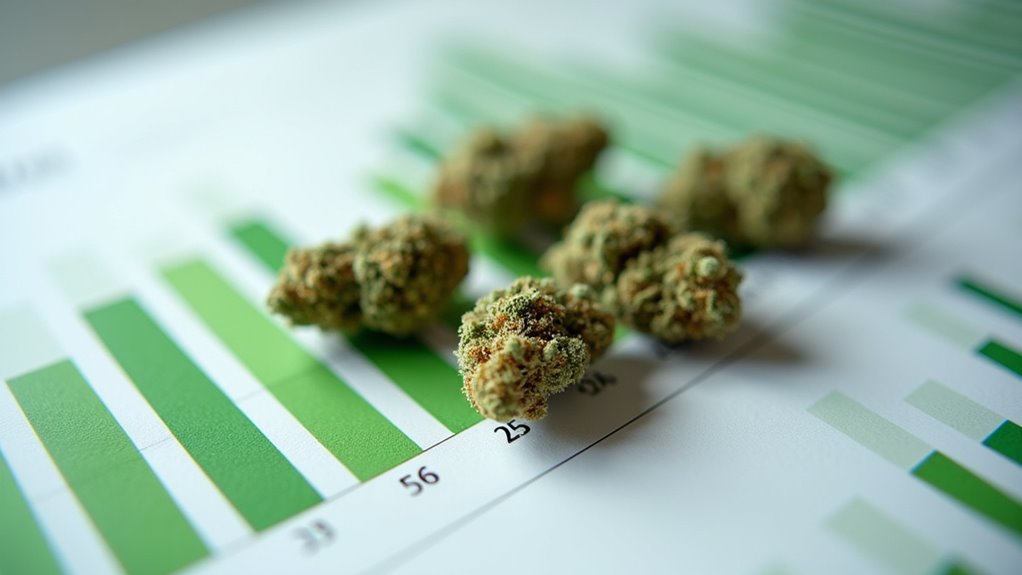Marijuana addiction affects approximately 30% of regular users, with your risk increasing considerably if you begin use during adolescence. You’ll face higher susceptibility if you carry specific genetic variants, which can amplify dependency chances up to fourfold. Current data shows three key risk factors: early initiation (ages 12-17), family history, and mental health conditions like ADHD (10x higher risk). Treatment options now include AI-driven coaching, virtual CBT, and personalized intervention strategies that can substantially improve your recovery outcomes.
Current Marijuana Usage Statistics Across Demographics

Five distinct demographic patterns emerge in current marijuana usage statistics, revealing significant variations across stage, gender, ethnicity, education, and region.
The 54% of Americans who reside in states with legal recreational marijuana access shapes current consumption trends. Millennials leading consumption at 51% of users, while Gen Z shows the fastest growth. Men consistently outpace women in usage rates (15% vs. 9-11%), reflecting persistent gender disparities. Currently, college student use has reached 44% in 2020, marking a notable increase from previous years.
Black Americans maintain the highest prevalence at 10.7%, followed by white (8.4%) and Hispanic (7.2%) populations, highlighting how socioeconomic status influences consumption patterns.
Education levels correlate inversely with usage 17% of non-college graduates report marijuana use compared to 11% of college graduates. The changing policy environment has shaped regional trends, with the West showing 19% usage rates while the South remains lowest at 11%. These patterns suggest complex demographic interactions in marijuana consumption behaviors.
Risk Factors and Predictors of Cannabis Dependence

Research consistently shows you’re at higher risk of developing cannabis dependence if you begin regular use during adolescence, when your brain is still developing critical neural pathways.
Your genetic makeup plays a significant role, with studies indicating that specific gene variants can make you up to four times more susceptible to cannabis use disorder. The rise in cannabis potency levels over recent decades has increased the risk of developing dependence among users.
Your social environment, including peer pressure, family inclinations regarding cannabis, and exposure to drug-using social networks, directly influences both your likelihood of initiating cannabis use and your probability of developing dependence. Current data indicates that three in ten cannabis users will eventually develop cannabis use disorder.
Early Use Age Impact
The stage at which someone initially uses marijuana profoundly influences their likelihood of developing cannabis use disorder, with 53% of adult users reporting initial exposure between ages 12-17. During these critical brain development milestones, you’re particularly vulnerable to addiction, as evidenced by the 17% dependency rate among teenage initiates compared to 9% throughout life. Males seek treatment more frequently and earlier than females for cannabis dependency.
Pre-12 exposure doubles your mental illness risk versus post-18 initiation, while adolescent impulsivity patterns contribute to heightened risk-taking behaviors. You’ll find this reflected in current usage trends, where 6.3% of 12th graders report daily use. With 29% of seniors dismissing regular marijuana use as harmless, the risk of early experimentation continues to rise.
The impact on cognitive development is significant, affecting memory and attention processes that continue developing into your early 20s. This neurological vulnerability helps explain why early users face substantially higher rates of polysubstance abuse and long-term dependency.
Genetic Predisposition Factors
Beyond lifespan-related vulnerabilities, genetic factors substantially shape your susceptibility to cannabis use disorder. Research shows that 50% of your addiction risk stems from inherited traits, with key genes like FOXP2 and CHRNA2 playing pivotal roles in dependency patterns and cross-substance vulnerabilities.
If you have ADHD, you’re particularly at risk, as shared genetic markers create a 10x higher chance of developing cannabis dependence. These overlapping genetic pathways affect both attention regulation and risk-taking behaviors. Danish studies reveal that individuals with specific CHRNA2 variants show increased vulnerability to developing cannabis use disorder.
Lower white matter volume in children with genetic susceptibility indicates vulnerability to cannabis use disorder may be present before any exposure to the drug.
In addition, cannabis use can trigger epigenetic modifications that may impact future generations, with evidence pointing to potential DNA damage and reproductive health concerns.
While genetic testing can’t yet predict your personal risk with certainty, understanding these hereditary factors helps healthcare providers develop more targeted prevention and treatment approaches.
Social Environment Influence
Social environments play a decisive role in shaping your vulnerability to cannabis dependence, with peer networks and family dynamics serving as primary catalysts. You’ll face heightened exposure risks through neighborhood drug trade dynamics and prevalent social media strategies that normalize cannabis use.
Your susceptibility increases when you’re surrounded by substance-using peers or living in chaotic home environments. Parental permissiveness and lack of supervision can substantially impact your likelihood of developing dependency. Research shows that genetic vulnerability factors account for approximately 40-60% of addiction risk. Statistics indicate that lower-income households show increased rates of early cannabis experimentation.
Media portrayals, particularly through celebrity endorsements and entertainment platforms, continue to diminish perceived risks. Community factors, including economic disparities and cultural subgroups, can further reinforce cannabis-seeking behaviors.
You’re especially vulnerable when multiple social influences converge such as peer pressure combining with family instability and media messaging that downplays addiction risks.
Youth and Young Adult Marijuana Consumption Patterns

Recent data reveals encouraging trends in youth marijuana consumption, with significant declines observed across multiple grade levels between 2011 and 2021. You’ll find that comprehensive usage rates have dropped from 23.1% to 15.8%, with perceived risk effects playing a pivotal role in consumption patterns.
Research indicates that parental communication and positive school environments contribute significantly to maintaining these declining trends in adolescent use.
Key grade-level reductions showcase this downward trend:
- 12th graders: 30.5% (down from 35.2%)
- 10th graders: 17.3% (down from 28%)
- 8th graders: 7.1% (down from 11.4%)
- Introductory use before young age 13: 4.9% (down from 8.1%)
States with legal recreational marijuana have demonstrated even more pronounced decreases, with potency and consumption regulated through licensed dispensaries replacing illegal dealers. This shift has effectively reduced youth access while maintaining strict age restrictions on purchases. Colorado serves as a prime example where high schooler usage decreased 42% since implementing adult-use legalization.
State-by-State Analysis of Marijuana Legalization Impact
As youth consumption patterns shift downward, state-level marijuana legalization continues to reshape America’s cannabis terrain. You’ll find stark contrasts in usage rates between medical-only and recreational states, with the latter showing considerably higher consumption levels. Western states lead adoption rates while southern regions maintain restrictive policies, creating opportunities for cross state trafficking. States like Georgia, Alabama, and Arizona experienced the lowest percent changes in marijuana usage between 2014-2017.
| State Type | Key Characteristics |
|---|---|
| Recreational | 74% population access, 8.6% usage increase |
| Medical Only | Stricter controls, lower usage rates |
| Southern States | Limited adoption, higher illicit use |
| Border States | Trafficking concerns, enforcement challenges |
| Rural Areas | Limited legal access, distribution gaps |
The impact varies dramatically by region, with urban areas benefiting from powerful commercial networks while rural legal access remains problematic. You’ll notice medical programs maintain stricter quality controls compared to recreational markets, where concerns about THC potency persist.
Mental Health Correlations With Cannabis Use Disorder
Disturbing mental health correlations consistently emerge between cannabis use disorder (CUD) and severe psychiatric outcomes. The data reveals a stark connection between heavy cannabis use and long term psychosis risk, particularly among young adults of an advanced/mature/adult age.
Your mental health risks dramatically increase with CUD, as evidenced by these critical findings:
- Weekly cannabis use doubles your risk of depression and anxiety
- Males aged 16-20 face a 3.84x higher schizophrenia risk
- Early onset psychosis onset is more prevalent/common in CUD patients
- Emergency psychiatric visits have surged 50% since 2019
You’re especially vulnerable if you have existing mental health conditions, as CUD creates a bi-directional relationship that can amplify psychiatric symptoms. This risk intensifies among those with genetic predispositions to psychosis and schizophrenia. Recent data shows cannabis-induced disorders led to over 14,500 emergency department visits during the study period. With marijuana use at record levels in the United States, these mental health risks pose an increasingly serious public health concern.
Emerging Trends in Marijuana Addiction Treatment
Digital recovery platforms are revolutionizing marijuana addiction treatment through AI-driven behavioral coaching and virtual CBT sessions you can access from any location. You’ll find these tools particularly effective when integrated with traditional therapy, as they provide real-time monitoring and personalized interventions that adapt to your recovery endeavor.
Treatment programs now offer life stage-specific approaches, recognizing that Gen-Z users require different engagement strategies than older adults, with digital therapeutics bridging generational preferences in recovery support.
Rising Digital Recovery Tools
The rapid evolution of technology has revolutionized marijuana addiction treatment, with revolutionary FDA-approved apps and AI-driven platforms now leading the charge in digital recovery. You’ll find data-driven interventions through platforms like reSET®, which has proven to double abstinence rates compared to traditional treatment methods.
Key digital recovery innovations include:
- HIPAA-compliant telehealth platforms offering 24/7 access to therapy and medication tracking
- AI-powered predictive analytics that identify potential relapse triggers
- Virtual reality environments for practicing coping skills in triggering situations
- Anonymous peer support networks providing instant crisis intervention
These tools utilize encrypted data handling and personalized coaching algorithms to deliver targeted support. The integration of VR therapy and online communities has created an extensive digital ecosystem that’s transforming how you approach marijuana addiction recovery, particularly in remote or underserved areas.
Cross-Generational Treatment Approaches
Modern addiction treatment recognizes that marijuana dependency manifests differently across life stages, requiring specialized approaches for ideal outcomes. Evidence-based rehabilitation models now emphasize multigenerational harm reduction strategies, tailoring interventions to cohort-specific needs and cultural contexts.
Young adults benefit from CBT and family-based therapies, while mid-life patients respond better to hybrid treatment combining pharmacological support with stress management techniques. Elderly individuals show improved outcomes through mindfulness-based relapse prevention (MBRP) and trauma-informed approaches. Cultural competency remains pivotal, with specialized protocols for marginalized communities showing promising results.
Treatment facilities increasingly adopt integrated care models, combining mental health services with addiction treatment. This all-encompassing approach addresses co-occurring disorders while acknowledging generational differences in marijuana use patterns and recovery needs.
Public Health Strategies for Prevention and Intervention
As marijuana legalization expands across 39 states with medical cannabis programs, public health authorities have implemented thorough strategies to address prevention and intervention needs. Data-driven policy implementation focuses on age restrictions and targeted education, while treatment access optimization guarantees extensive care availability.
State-led medical cannabis legalization demands robust public health strategies balancing prevention needs with accessible treatment options.
Current prevention strategies target key demographics, addressing:
- 40% of high school students reporting marijuana use
- 44% of adults aged 19-30 with past-year usage
- 28% of adults aged 35-50 using cannabis
- Gender disparities showing 15% male versus 9% female usage
You’ll find improved access to treatment through telehealth platforms, CBT services, and integrated primary care options. School-based programs now incorporate cannabis education in middle school curricula, while community workshops address safety myths and legal implications. These interventions represent a coordinated approach between federal and state agencies to align prevention efforts.
Frequently Asked Questions
How Long Does Marijuana Stay Detectable in Different Drug Tests?
Marijuana detection times vary remarkably across test types. In your urine, single use remains detectable for 3 days, while heavy use can show up for over 30 days.
Blood screening typically detects recent use within 2-12 hours, though chronic users may test positive for up to 30 days. You’ll test positive on saliva screens for up to 72 hours, while hair tests can reveal your marijuana use for up to 90 days.
Can Secondhand Marijuana Smoke Show up on Employment Drug Screenings?
While second hand smoke consequences from marijuana exposure are possible, you’re unlikely to fail an employment drug test from casual passive exposure.
However, pass through exposure concerns are valid in extreme conditions like being in an unventilated space with heavy cannabis smoke for extended periods. You’d typically need intense, prolonged exposure to reach detectable THC levels.
Standard workplace testing thresholds are designed to distinguish between active use and incidental exposure.
What Natural Remedies Help Manage Marijuana Withdrawal Symptoms?
You can manage marijuana withdrawal symptoms effectively through several natural approaches. Start with daily yoga practices and meditation techniques to reduce anxiety and improve sleep quality.
Stay well-hydrated and maintain balanced nutrition while incorporating herbal remedies like chamomile tea and St. John’s Wort. Regular exercise, consistent sleep schedules, and B-complex vitamins can help stabilize your mood.
Consider magnesium supplements to ease muscle tension and support relaxation.
Does Marijuana’s THC Content Affect Addiction Potential Differently Than CBD?
Yes, THC and CBD affect addiction risk very differently. Higher THC potency levels drastically increase your chances of developing dependency, as it strongly activates brain reward circuits and can lead to more severe withdrawal effects.
In contrast, CBD doesn’t cause addiction and may actually help reduce THC’s addictive potential. You’ll find that modern cannabis strains with high THC-to-CBD ratios pose greater addiction risks than balanced formulations.
Can Prescription Medications Interact Dangerously With Recreational Marijuana Use?
Yes, your prescription medications can interact dangerously with marijuana usage patterns. You’re at particularly high risk when combining cannabis with sedatives, anticoagulants, or psychiatric medications.
THC and CBD can interfere with how your body processes drugs through enzyme inhibition, potentially leading to toxic buildup or reduced effectiveness. You’ll need to be especially cautious with blood thinners, antidepressants, and anti-anxiety medications, as these combinations can cause serious adverse effects or life-threatening complications.

